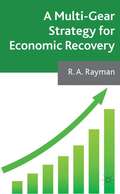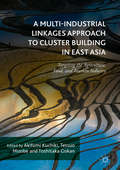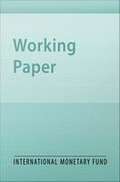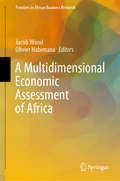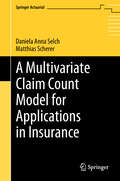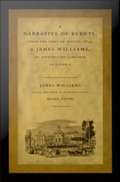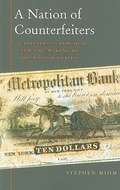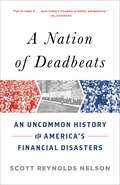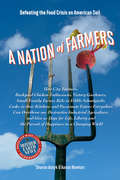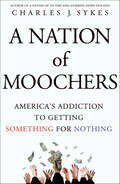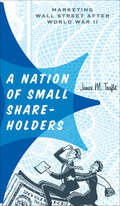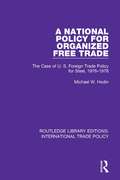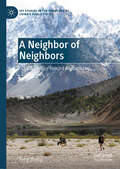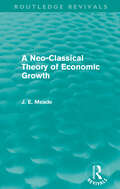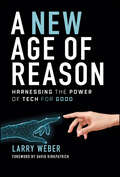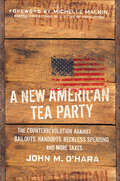- Table View
- List View
A Moving Target: Real World Strategies for Applying 5 Forces, Selecting and Using Appropriate Tools, and Reacting to Feedback
by Jay Barney Patricia Gorman Clifford"What I Didn't Learn in Business School" follows new consultant Justin Campbell as he joins an elite team hired by a chemical firm to assess the potential of a newly developed technology. Read along as Justin meets with a vice president, the second-in-command at the chemical firm. Throughout the interview, Justin learns that a particular mode of analysis is not applicable to every situation. Like any newcomer, he tries to match a case study to a real-world situation-but business is not a science. In the real world, it's often difficult to distinguish the wrong from the right approach. Different strategies, as Justin learns, have advantages and disadvantages in different scenarios. In this chapter, authors Jay Barney and Trish Gorman Clifford demonstrate how to develop real-world strategies for applying the Five Forces framework, and for using feedback to your advantage. This chapter was originally published as Chapter 3 of "What I Didn't Learn in Business School: How Strategy Works in the Real World."
A Multi-Gear Strategy for Economic Recovery
by R. A. RaymanVolume II proposes radical reform (1) of the accounting system - to bring corporate management under the control of market forces; and (2) of the tax system - to enable the economy to grow to its full potential and to establish an automatic mechanism for price stability without any arbitrary intervention.
A Multi-Industrial Linkages Approach to Cluster Building in East Asia: Targeting the Agriculture, Food, and Tourism Industry
by Akifumi Kuchiki Tetsuo Mizobe Toshitaka GokanThis book proposes measures to promote regional industrial development in East Asia from the perspective of three industries: agriculture, food, and tourism. The authors argue that for regional agriculture to develop, collaboration with the food industry is essential. Further, by linking tourism, economic collaboration between the three industries is strengthened. The first part of the book introduces a basic model for the formation of the agriculture, food, and tourism industry cluster. Contributions from leading academics in agricultural economics then go on to discuss the relevance of this multi-industry cluster in countries such as Japan, the Republic of Korea, and Cambodia, amongst others. The final part sets out new approaches for further development in the cluster through quantitative analyses of the 'economies of sequence' concept. Readers will discover that from establishing linkages between different industries and other economic sectors, important positive externalities can be generated and these processes can be triggered on the local or cluster level.
A Multi-industry Model of Growth with Financing Constraints
by Anna Ilyina Roberto SamaniegoA report from the International Monetary Fund.
A Multidimensional Economic Assessment of Africa (Frontiers in African Business Research)
by Jacob Wood Olivier HabimanaThis book is a useful resource for government policy analysts, academics, students of higher education and business practitioners interested in African economies and the key economic issues these economies are facing in 2020. In the face of weak governance and growth globally, there is still a window of opportunity for countries in Africa to build on not only their traditional industrial capabilities, but also pave the way for positive developments in international trade and in the way governments tackle poverty and inequality. By focusing on four areas: (1) agriculture and livestock, (2) consumption, poverty and inequality, (3) financial services, employment and corporate governance, and (4) economic integration, international trade and foreign direct investment (FDI), this book presents a series of empirical studies that examine important contemporary economic issues facing Africa. The book incorporates a range of methodological approaches, with some chapters providing case study analyses while others embrace more traditional forms of econometric testing.
A Multivariate Claim Count Model for Applications in Insurance (Springer Actuarial)
by Matthias Scherer Daniela Anna SelchThis monograph presents a time-dynamic model for multivariate claim counts in actuarial applications. Inspired by real-world claim arrivals, the model balances interesting stylized facts (such as dependence across the components, over-dispersion and the clustering of claims) with a high level of mathematical tractability (including estimation, sampling and convergence results for large portfolios) and can thus be applied in various contexts (such as risk management and pricing of (re-)insurance contracts). The authors provide a detailed analysis of the proposed probabilistic model, discussing its relation to the existing literature, its statistical properties, different estimation strategies as well as possible applications and extensions. Actuaries and researchers working in risk management and premium pricing will find this book particularly interesting. Graduate-level probability theory, stochastic analysis and statistics are required.
A Multivariate Filter for Measuring Potential Output and the NAIRU: Application to the Czech Republic
by Papa N'Diaye Jaromir BenesA report from the International Monetary Fund.
A Narrative of Events, since the First of August, 1834, by James Williams, an Apprenticed Labourer in Jamaica
by James WilliamsThis book brings back into print, for the first time since the 1830s, a text that was central to the transatlantic campaign to fully abolish slavery in Britain's colonies. James Williams, an eighteen-year-old Jamaican "apprentice" (former slave), came to Britain in 1837 at the instigation of the abolitionist Joseph Sturge. The Narrative he produced there, one of very few autobiographical texts by Caribbean slaves or former slaves, became one of the most powerful abolitionist tools for effecting the immediate end to the system of apprenticeship that had replaced slavery. Describing the hard working conditions on plantations and the harsh treatment of apprentices unjustly incarcerated, Williams argues that apprenticeship actually worsened the conditions of Jamaican ex-slaves: former owners, no longer legally permitted to directly punish their workers, used the Jamaican legal system as a punitive lever against them. Williams's story documents the collaboration of local magistrates in this practice, wherein apprentices were routinely jailed and beaten for both real and imaginary infractions of the apprenticeship regulations. In addition to the complete text of Williams's original Narrative, this fully annotated edition includes nineteenth-century responses to the controversy from the British and Jamaican press, as well as extensive testimony from the Commission of Enquiry that heard evidence regarding the Narrative's claims. These fascinating and revealing documents constitute the largest extant body of direct testimony by Caribbean slaves or apprentices.
A Nation Divided: The United States and the Challenge of Secession
by David A. Moss Marc CampasanoAmericans elected Abraham Lincoln as the nation's first Republican president in November of 1860. Northern political leaders had formed the Republican Party only a few years before, in large measure to combat the spread of slavery. Southerners had long been wary of Northern hostility toward their "peculiar institution," and Lincoln's 1860 victory proved to be the last straw in this sectional rivalry that had deeply influenced American culture and politics since the earliest days of the republic. By the time of Lincoln's inauguration five months later, in March 1861, seven Southern states had announced their decision to secede from the Union. Lincoln rejected secession as unlawful and pledged that his government would continue to exercise its authority, as best it could, in the rebellious states. A crisis in South Carolina, the first state to secede, tested Lincoln's mettle in the opening days of his presidency. Federal troops still held Fort Sumter in Charleston harbor, but their supplies were running low. Lincoln would either have to evacuate the fort or risk war by sending provisions. The new president understood the weight of the choice he faced: nothing less than the survival of the Union was at stake.
A Nation of Counterfeiters: Capitalists, Con Men, and the Making of the United States
by Stephen MihmListen to a short interview with Stephen MihmHost: Chris Gondek | Producer: Heron & Crane Few of us question the slips of green paper that come and go in our purses, pockets, and wallets. Yet confidence in the money supply is a recent phenomenon: prior to the Civil War, the United States did not have a single, national currency. Instead, countless banks issued paper money in a bewildering variety of denominations and designs--more than ten thousand different kinds by 1860. Counterfeiters flourished amid this anarchy, putting vast quantities of bogus bills into circulation. Their success, Stephen Mihm reveals, is more than an entertaining tale of criminal enterprise: it is the story of the rise of a country defined by a freewheeling brand of capitalism over which the federal government exercised little control. It was an era when responsibility for the country's currency remained in the hands of capitalists for whom "making money" was as much a literal as a figurative undertaking. Mihm's witty tale brims with colorful characters: shady bankers, corrupt cops, charismatic criminals, and brilliant engravers. Based on prodigious research, it ranges far and wide, from New York City's criminal underworld to the gold fields of California and the battlefields of the Civil War. We learn how the federal government issued greenbacks for the first time and began dismantling the older monetary system and the counterfeit economy it sustained. A Nation of Counterfeiters is a trailblazing work of history, one that casts the country's capitalist roots in a startling new light. Readers will recognize the same get-rich-quick spirit that lives on in the speculative bubbles and confidence games of the twenty-first century.
A Nation of Deadbeats: An Uncommon History of America's Financial Disasters
by Scott Reynolds NelsonThe story of America is a story of dreamers and defaulters. It is also a story of dramatic financial panics that defined the nation, created its political parties, and forced tens of thousands to escape their creditors to new towns in Texas, Florida, and California. As far back as 1792, these panics boiled down to one simple question: Would Americans pay their debts--or were we just a nation of deadbeats? From the merchant William Duer's attempts to speculate on post-Revolutionary War debt, to an ill-conceived 1815 plan to sell English coats to Americans on credit, to the debt-fueled railroad expansion that precipitated the Panic of 1857, Scott Reynolds Nelson offers a crash course in America's worst financial disasters--and a concise explanation of the first principles that caused them all. Nelson shows how consumer debt, both at the highest levels of finance and in the everyday lives of citizens, has time and again left us unable to make good. The problem always starts with the chain of banks, brokers, moneylenders, and insurance companies that separate borrowers and lenders. At a certain point lenders cannot tell good loans from bad--and when chits are called in, lenders frantically try to unload the debts, hide from their own creditors, go into bankruptcy, and lobby state and federal institutions for relief. With a historian's keen observations and a storyteller's nose for character and incident, Nelson captures the entire sweep of America's financial history in all its utter irrationality: national banks funded by smugglers; fistfights in Congress over the gold standard; and presidential campaigns forged in stinging controversies on the subject of private debt. A Nation of Deadbeats is a fresh, irreverent look at Americans' addiction to debt and how it has made us what we are today.
A Nation of Farmers
by Sharon Astyk Aaron Newton"Astyk and Newton have written an important book with an unusual message: We need millions of new farmers...as soon as possible. You could not find two more reasonable, intelligent, sincere, and passionate people to talk to about food. And the book has very much the feeling of a conversation - with someone smart who cares about you. It is also intellectually complex, creative and nuanced. The authors are big thinkers and have taken a good lick at the central human issues of our time." Peter Bane "This definitive guide can provide inspiration to gardeners and those concerned about the environment. It offers practical solutions to all the food-related problems brought on by industrialized agriculture and the globalization of food. Very carefully researched and well written, this documents what is wrong and what we can do about it." Connie Krochmal - Bellaonline "This outstanding and well-written compendium of insights and recommendations, of fervent idealism and practical solutions, is highly recommended."--Library Journal Once we could fill our grocery carts with cheap and plentiful food, but not anymore. Cheap food has gone the way of cheap oil. Climate change is already reducing crop yields worldwide. The cost of flying in food from far away and shipping it across the country in refrigerated trucks is rapidly becoming unviable. Cars and cows increasingly devour grain harvests, sending prices skyrocketing. More Americans than ever before require food stamps and food pantries just to get by, and a worldwide food crisis is unfolding, overseas and in our kitchens. We can keep hunger from stalking our families, but doing so will require a fundamental shift in our approach to field and table. A Nation of Farmers examines the limits and dangers of the globalized food system and shows how returning to the basics is our best hope. The book includes in-depth guidelines for: Creating resilient local food systems Growing, cooking, and eating sustainably and naturally Becoming part of the solution to the food crisis The book argues that we need to make self-provisioning, once the most ordinary of human activities, central to our lives. The results will be better food, better health, better security, and freedom from corporations that don't have our interests at heart. This is critical reading for anyone who eats and cares about high-quality food. Sharon Astyk farms in New York, and is the author of Depletion and Abundance. Aaron Newton is a sustainable systems land planner in North Carolina, and is the founding editor of Groovy Green.
A Nation of Moochers: America's Addiction to Getting Something for Nothing
by Charles J. SykesWe have experienced a shift in American character: we've become a nation of moochers. Increasingly dependent on the efforts of others over our own, Americans are free to freeload. From the corporate bailouts on Wall Street to the alarming increases in personal default and dependency, from questionable tax exemptions to enormous pension, healthcare, and other entitlement costs, the new moocher culture cuts across lines of class, race, and private and public sectors. And the millions that plan and behave sensibly, only to bail out the profligate? They're angry.Charles Sykes' argument is not against compassion or legitimate charity, but targets the new moocher culture, in which self-reliance and personal responsibility have given way to mass grasping after handouts. A Nation of Moochers is a persuasively argued and entertaining rallying cry for Americans who are tired of playing by the rules and paying for those who don't.
A Nation of Realtors®: A Cultural History of the Twentieth-Century American Middle Class
by Jeffrey M. HornsteinHow is it that in the twentieth century virtually all Americans came to think of themselves as "middle class"? In this cultural history of real estate brokerage, Jeffrey M. Hornstein argues that the rise of the Realtors as dealers in both domestic space and the ideology of home ownership provides tremendous insight into this critical question. At the dawn of the twentieth century, a group of prominent real estate brokers attempted to transform their occupation into a profession. Drawing on traditional notions of the learned professions, they developed a new identity--the professional entrepreneur--and a brand name, "Realtor. " The Realtors worked doggedly to make home ownership a central element of what became known as the "American dream. " Hornstein analyzes the internal evolution of the occupation, particularly the gender dynamics culminating in the rise of women brokers to predominance after the Second World War. At the same time, he examines the ways organized real estate brokers influenced American housing policy throughout the century. Hornstein draws on trade journals, government documents on housing policy, material from the archives of the National Association of Realtors and local real estate boards, demographic data, and fictional accounts of real estate agents. He chronicles the early efforts of real estate brokers to establish their profession by creating local and national boards, business practices, ethical codes, and educational programs and by working to influence laws from local zoning ordinances to national housing policy. A rich and original work of American history, A Nation of Realtors illuminates class, gender, and business through a look at the development of a profession and its enormously successful effort to make the owner-occupied, single-family home a key element of twentieth-century American identity.
A Nation of Small Shareholders: Marketing Wall Street After World War II (Studies in Industry and Society)
by Janice M. TrafletThe little-known story of Wall Street’s effort to court individual investors during the Cold War in order to build a bulwark against communism.Immediately after the frightening Great Crash of 1929, many Americans swore they would never—or never again—become involved in the stock market. Yet hordes of Americans eventually did come to embrace equity investing, to an extent actually far greater than the level of popular involvement in the market during the Roaring Twenties. A Nation of Small Shareholders explores how marketers at the New York Stock Exchange during the mid-twentieth century deliberately cultivated new individual shareholders.Janice M. Traflet examines the energy with which NYSE leaders tried to expand the country’s retail investor base, particularly as the Cold War emerged and then intensified. From the early 1950s until the 1970s, Exchange executives engaged in an ambitious and sometimes controversial marketing program known as “Own Your Share of America,” which aimed to broaden the country’s shareholder base. The architects of the marketing program ardently believed that widespread share ownership would strengthen “democratic capitalism”—which, in turn, would serve as an effective barrier to the potential allure of communism here in the United States.Based on extensive primary source research, A Nation of Small Shareholders illustrates the missionary zeal with which Big Board leaders during the Cold War endeavored to convince factions within the Exchange, as well as the public, of the practical and ideological importance of building a true shareholder nation.
A Nation of Small Shareholders: Marketing Wall Street after World War II (Studies in Industry and Society)
by Janice M. TrafletHow New York Stock Exchange leaders in the decades after the Great Crash of 1929 helped popularize equity investing.Immediately after the frightening Great Crash of 1929, many Americans swore they would "never" or "never again" become involved in the stock market. Yet hordes of Americans eventually did come to embrace equity investing, to an extent actually far greater than the level of popular involvement in the market during the Roaring 1920s. A Nation of Small Shareholders explores how marketers at the New York Stock Exchange during the mid twentieth century deliberately cultivated new individual shareholders.Janice M. Traflet examines the energy with which NYSE leaders tried to expand the country’s retail investor base, particularly as the Cold War emerged and then intensified. From the early 1950s until the 1970s, Exchange executives engaged in an ambitious and sometimes controversial marketing program known as "Own Your Share of America," which aimed to broaden the country’s shareholder base. The architects of the marketing program ardently believed that widespread shareownership would strengthen "democratic capitalism" which, in turn, would serve as an effective barrier to the potential allure of communism here in the United States.Based on extensive primary source research, A Nation of Small Shareholders illustrates the missionary zeal with which Big Board leaders during the Cold War endeavored to convince factions within the Exchange as well as the outside public of the practical and ideological importance of building a true shareholder nation.In these troubled economic times, every citizen should welcome studies that shed light on U.S. financial markets. A Nation of Small Shareholders puts the role of individual investors in broader, long-term perspective.
A Nation's Paper: The Globe and Mail in the Life of Canada
by John IbbitsonFrom Canada's newspaper of record for 180 years, here are thirty-one brilliant and provocative essays by a diverse selection of their writers on how The Globe and Mail covered and influenced major events and issues from the paper&’s founding to the latest file. Since 1844, the Globe and Mail and its predecessor, George Brown&’s Globe, have chronicled Canada: as a colony, a dominion, and a nation. To mark the paper&’s 180th anniversary, Globe writers explored thirty issues and events in which the national newspaper has influenced the course of the country: Confederation, settler migrations, regional tensions, tussles over language, religion, and race. The essays reveal a tapestry of progress, conflict, and still-incomplete reconciliation: Catholic-Protestant hostilities that are now mostly the stuff of memory; the betrayal of Indigenous peoples with which we still grapple; the frustrations and triumphs of women journalists; pandemics old and new; environmental challenges; the joys of covering sports and the arts; chronicling the nation&’s business, international coverage, the impossibility of Canada and of this newspaper, which both somehow flourish nonetheless. Riveting, insightful, disturbing, witty, and always a joy to read, A Nation&’s Paper chronicles a country and a newspaper that have grown and struggled together – essential reading for anyone who wants to understand where we came from and where we are going. The Globe and Mail will donate all its proceeds from the book to Journalists for Human Rights.
A National Policy for Organized Free Trade: The Case of U.S. Foreign Trade Policy for Steel, 1976-1978 (Routledge Library Editions: International Trade Policy #18)
by Michael W. HodinSince the completion of the original writing in 1978, and the publication of this Garland edition in 1987, several important events came to pass which underscored the importance and relevance of the study of the US foreign trade policy toward steel in the late seventies. One can read the story of US trade policy toward steel in 1977-79 as a critical step in the path which has been moving the US from a policy of organised free trade to one where increasing scope is allowed to market forces.
A Natural Experiment on Electoral Law Reform: Evaluating the Long Run Consequences of 1990s Electoral Reform in Italy and Japan (Studies in Public Choice #24)
by Bernard Grofman Daniela GiannettiIn the early 1990s, major electoral reforms took place in both Italy and Japan; each replaced a form of "proportional representation" (in which voters cast a ballot for a party list) with a "mixed member" system (in which voters cast ballots for individual candidates and party lists). The reforms were enacted by political elites in the context of divisions within the dominant party, changing patterns of party support, and party splits, in efforts to retain power while responding to charges of corruption, clientelism, and lack of accountability. The experiences of both countries provide a laboratory in which to investigate the effects and implications of the reforms, and, more broadly to analyze voter behavior in the context of institutional change. The introduction provides an overview of post-WWII politics and electoral reform in Italy and Japan. In each of the next four chapters, specialists in Italian and Japanese electoral politics are teamed up to review data both before and after the reforms. Within this comparative framework, the authors explore such topics as changes in party competition, candidate selection mechanisms, and intra-party politics. The concluding chapter considers the longer-term consequences--both anticipated and unanticipated--of the reforms; despite superficially similar conditions, the effects in the two countries were dramatically different: in Japan, the new system has taken hold, with minor modifications, while in Italy, there was a reversion to a proportional representation system. As the essays in this volume demonstrate, to understand why similar reforms had such different effects in the two countries we must examine how electoral systems are embedded in broader institutional and social arrangements, and at the complex interplay of political geography, political history, and the rational calculations of political actors.
A Natural History of Belize: Inside the Maya Forest (Corrie Herring Hooks Series)
by Samuel BridgewaterBelize's Chiquibul Forest is one of the largest remaining expanses of tropical moist forest in Central America. It forms part of what is popularly known as the Maya Forest. Battered by hurricanes over millions of years, occupied by the Maya for thousands of years, and logged for hundreds of years, this ecosystem has demonstrated its remarkable ecological resilience through its continued existence into the twenty-first century. Despite its history of disturbance, or maybe in part because of it, the Maya Forest is ranked as an important regional biodiversity hot spot and provides some of the last regional habitats for endangered species such as the jaguar, the scarlet macaw, Baird's tapir, and Morelet's crocodile. A Natural History of Belize presents for the first time a detailed portrait of the habitats, biodiversity, and ecology of the Maya Forest, and Belize more broadly, in a format accessible to a popular audience. It is based in part on the research findings of scientists studying at Las Cuevas Research Station in the Chiquibul Forest. The book is unique in demystifying many of the big scientific debates related to rainforests. These include "Why are tropical forests so diverse?"; "How do flora and fauna evolve?"; and "How do species interact?" By focusing on the ecotourism paradise of Belize, this book illustrates how science has solved some of the riddles that once perplexed the likes of Charles Darwin, and also shows how it can assist us in managing our planet and forest resources wisely in the future.
A Neighbor of Neighbors: China’s Policy Toward Afghanistan, 1949–2024 (IPP Studies in the Frontiers of China’s Public Policy)
by Feng ZhangThis book explores China's role, past, present and future, in Afghanistan. The chaotic withdrawal of the United States from Afghanistan in August 2021 after a 20-year intervention left China as the biggest regional country capable of playing a critical role in future Afghan affairs dominated by the Taliban. What is China&’s policy toward Afghanistan after the US withdrawal? How will it seek to increase its influence? To answer these pressing questions, it is necessary to understand how China&’s policy toward Afghanistan has evolved historically. This book examines China&’s relations with Afghanistan from a combination of theoretical and historical perspectives, highlighting the goals of amity, security, and influence in Chinese policy. This is a study that will be of great value to scholars of Asian politics and geopolitics, and the emerging order in Central Asia.
A Neo-Classical Theory of Economic Growth (Collected Works of James Meade)
by James E. MeadeFirst published in 1960, this seminal work illuminates the interrelations of the various approaches to the theory of economic growth. Professor Meade seeks to understand the factors which determine the speed of economic growth and outlines the ways in which classical economic analysis may be developed for application to the problem of economic growth.
A New Age of Reason: Harnessing the Power of Tech for Good
by Larry WeberLeverage technology to propel humankind toward a better future A New Age of Reason: Harnessing the Power of Tech for Good provides a roadmap for integrating emerging world-changing technologies, such as AI/robotics, chips/sensors, and quantum computing, to solve some of today’s thorniest and most pressing problems like climate change and world hunger. The author offers inspiring examples of companies using technology to positively impact humanity. The book provides an actionable playbook to transform your organization around this mission, including how to develop a tech for good strategy, how to evolve the C Suite to deliver on this mission, how to market it, as well as measure outcomes. The author also discusses the latest technology breakthroughs delivering positive world outcomes, such as: Extending a surgeon’s “eyes and hands” via robotics surgical systems to improve patient outcomes Computer vision tech that enables farmers to maximize crops to feed our burgeoning population AI/robotics that identify and fight wildfires Bringing together a collective of major thinkers on this subject and providing guidance for a better future, A New Age of Reason: Harnessing the Power of Tech for Good is a timely read for all executive leaders seeking to harness the new wave of technology to solve key societal problems and have a positive impact on the world.
A New American Labor Movement: The Decline of Collective Bargaining and the Rise of Direct Action
by William E. ScheuermanThe American labor movement isn't dead. It's just moving from the bargaining table to the streets. In A New American Labor Movement, William Scheuerman analyzes how the decline of unions and the emergence of these new direct-action movements are reshaping the American labor movement. Tens of thousands of exploited workers—from farm laborers and gig drivers to freelance artists and restaurant workers—have taken to the streets in a collective attempt to attain a living wage and decent working conditions, with or without the help of unions. This new worker militancy, expressed through mass demonstrations, strikes, sit-ins, political action, and similar activities, has already achieved much success and offers models for workers to exercise their power in the twenty-first century. Finally, Scheuerman notes, many of the strategies of the new direct-action groups share features with the sectoral bargaining model that dominates the European labor movement, suggesting that sectoral bargaining may become the foundation of a new American labor movement.
A New American Tea Party
by Michelle Malkin John M. O'HaraThe tax protester manifesto, written by a leading organizer of the tea party protestsOn April 15, 2009, a grassroots contingency of Americans that would soon become known around the world as the Tea Party made front-page news. Angered by years of excessive government spending-taxpayer financed bailouts of businesses deemed too big to fail and taxpayer handouts to special interest groups-Americans of all ages and all walks of life took to the streets to take back their country. A New American Tea Party: The Counterrevolution Against Bailouts, Handouts, Reckless Spending, and More Taxes is their story, and it's your guide for contributing to the movement to rein in government spending. The bookSummarizes the Tea Party movementExplains how the Tea Party protests were organizedPresents a call to action for continuing protests and describes how to best coordinate themThe debt resulting from today's reckless government spending will eventually result in massive tax hikes. A New American Tea Party shows how to focus your outrage into a productive movement that will make a positive difference.

